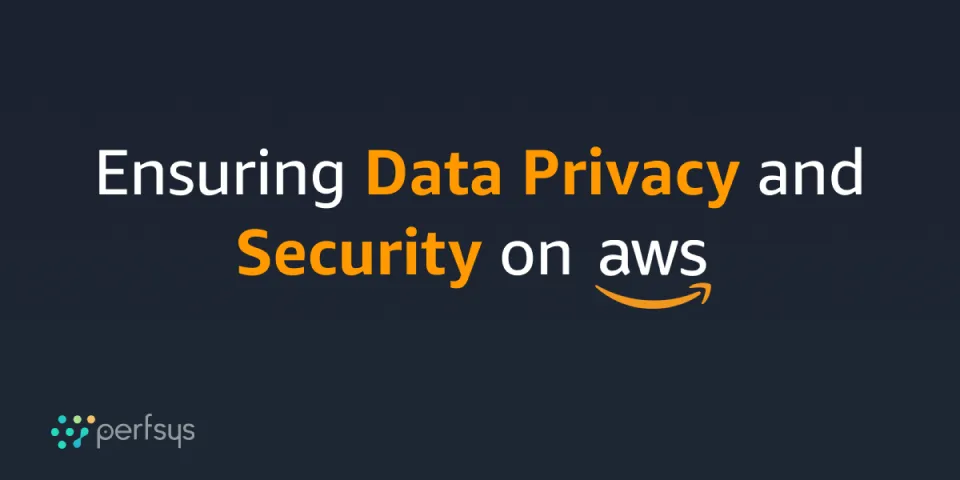Ensuring Data Privacy and Security on AWS
Contents
- - Introduction
- - The AWS Shared Responsibility Model
- - The AWS Well-Architected Framework
- - Best Practices for Ensuring Data Privacy and Security on AWS
- - Conclusion

Introduction
In the age of data abundance, one cannot overestimate the importance of data privacy and security. Organizations providing services to their customers must prioritize the safeguarding of sensitive information. According to the Cisco 2023 Data Privacy Benchmark Study, 94% of organizations believe that consumers will refrain from doing business with them if their data is not adequately protected.
As a business working with Amazon Web Services (AWS), we know it plays a rather important role in enabling companies to secure their data, following the AWS Shared Responsibility Model as well as the AWS Well-Architected Framework, a set of best practices related to designing applications in the cloud. In this article, we want to explore how AWS helps protect data, your responsibilities, and best practices for ensuring data privacy and security.
The AWS Shared Responsibility Model
AWS, as a leading cloud service provider, assumes a significant share of the responsibility for data security. It protects the underlying infrastructure, comprising hardware, software, networking, and facilities that power AWS Cloud services. It also offers powerful encryption features to secure data in transit and at rest. However, it’s crucial to understand that security on AWS is a shared responsibility between the cloud provider and the customer. While AWS manages the infrastructure, customers are responsible for their data and applications running on AWS services.
The AWS Well-Architected Framework
AWS provides a robust set of best practices known as the Well-Architected Framework to help organizations effectively design and manage workloads in the cloud. Among the six pillars of this framework, security holds a paramount position. The security pillar focuses on protecting information and systems, emphasizing the confidentiality and integrity of data, managing user permissions, and establishing controls to detect security events.
Best Practices for Ensuring Data Privacy and Security on AWS
1. Identify and Classify Your Data
Before keeping data in the cloud, identify and classify the information you plan to store. Determine whether any of it falls under protected categories such as personal identifiable information (PII), protected health information (PHI), intellectual property (IP), or other sensitive data. AWS services like Macie can assist in discovering sensitive data already stored in S3 buckets, DynamoDB tables, or RDS databases.
2. Define Data Protection Controls
Once you know your data, establish data protection policies. This involves using resource tags, separate AWS accounts per sensitivity level, IAM policies, AWS Organizations SCPs (Service Control Policies), AWS Key Management Service (KMS), and AWS CloudHSM. Adhere to the principle of least privilege, granting resources and individuals only the permissions required for specific tasks.
3. Protect Data at Rest
Data at rest refers to information stored in non-volatile storage for any duration of your workload. To mitigate the risk of unauthorized access, implement encryption and appropriate access controls. Secure key management, like AWS KMS, encryption of resources, automation through AWS Config rules and AWS Security Hub, and strict data sharing practices are essential for safeguarding data at rest.
4. Protect Data in Transit
Data in transit encompasses information transmitted from one system to another, including communication within your workload and between AWS services and end users. To ensure confidentiality and integrity during transit, you should enforce secure key and certificate management. Use secure TLS protocols and cipher suites for encryption. Automate the detection of unintended data access with tools such as Amazon GuardDuty, Amazon S3 Access Analyzer, and Amazon Macie. Opt for network protocols supporting authentication and authorization to enhance control over network flows and reduce the risk of unauthorized access.
Conclusion
Data security is a vast and complicated field that demands unwavering commitment. Today, organizations must prioritize data protection and privacy, including when operating in the cloud. While AWS offers a robust foundation for safeguarding data, customers must actively commit to securing their data and applications.
Following the best practices outlined in this article and continuously monitoring and adapting security measures, organizations can maintain trust and meet data privacy expectations. In the ever-evolving landscape of data privacy and security, a proactive approach on AWS is not just advisable; it’s essential.
